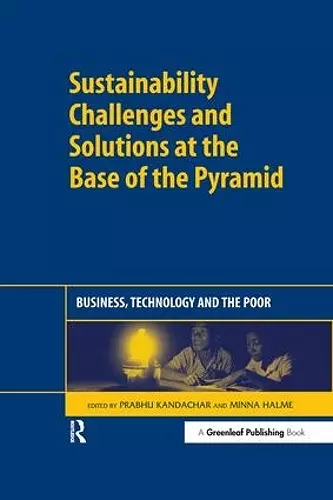Sustainability Challenges and Solutions at the Base of the Pyramid
Business, Technology and the Poor
Prabhu Kandachar editor Minna Halme editor
Format:Hardback
Publisher:Taylor & Francis Ltd
Published:1st Sep '08
Currently unavailable, and unfortunately no date known when it will be back

"This wonderful collection of essays ... a rich set of contributions by a diverse set of highly qualified authors ... between these covers lie many answers, but also a host of new and important questions regarding the promising new approach to sustainable development called the Base of the Pyramid." Stuart L. Hart
Around the turn of the millennium it had become painfully evident that development aid, charity or "global business-as-usual" were not going to be the mechanisms to alleviate global poverty. This book takes a bottom-up human-centred approach and examines examples that engage the poor in BoP product and service development.
Around the turn of the millennium it had become painfully evident that development aid, charity or "global business-as-usual" were not going to be the mechanisms to alleviate global poverty. Today, there is little dispute that poverty remains the most pressing global problem calling for innovative solutions. One recent strategy is the Base of the Pyramid (BoP) concept developed by Prahalad and Hart, which relies on entrepreneurial activity tapping into the previously ignored markets of the economically most disadvantaged. It is a process requiring innovations in several disciplines: technological, social and business.This book covers a number of areas. First, much of the current BoP discussion emphasises targeting products to the needs of the poor. But do we actually know what the real needs of the poor are?
This book takes a bottom-up human-centred approach and examines examples that truly engage the poor in BoP product and service development. What types of needs assessment methodologies are indicated considering the cultural differences in BoP countries? Are the existing methodologies adequate? Do they need to be redefined and redeveloped?
Second, the book considers how we can balance poverty alleviation and stimulate economic growth without stressing the ecosystem. Tragically, the poor are hardest hit by the adverse effects of environmental deterioration such as water shortages, climate change or the destruction of habitats. While the economic welfare of the poor is critical, the BoP approach must balance its inherent paradox of encouraging greater consumption while avoiding further pressures on environmental sustainability. The link between the BoP approach and sustainable development is a key feature of this book.
Third, it looks at innovation and asks what kinds of"bottom-up" innovation (open source, technological, social and business) support BoP initiatives (and sustainable development)?Fourth, the book deals with the relationship between development assistance and BoP. Is a BoP strategy the antithesis to development aid or can these two co-exist or even complement each other?Finally, the book raises questions about the relationship between corporate responsibility and BoP. Is BoP a...
Tackling the issue of poverty on a global scale, this title provides an in depth look at the requirement to consider the needs of the poor in developing products and services. The base of the pyramid (BoP) approach adopted by the authors has allowed them to investigate the markets previously ignored – those of the most disadvantaged economically. Presenting an objective review of the subject, this title contains detailed contributions from both supporters and critics of the BoP approach, suggesting not just answers to the problems, but raising vital questions regarding this new approach to sustainable development. - The Environmentalist 89 (7 December 2009)
ISBN: 9781906093112
Dimensions: unknown
Weight: 520g
544 pages